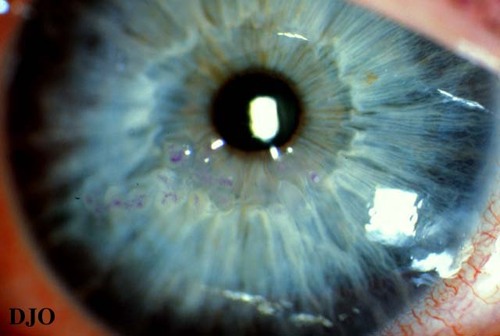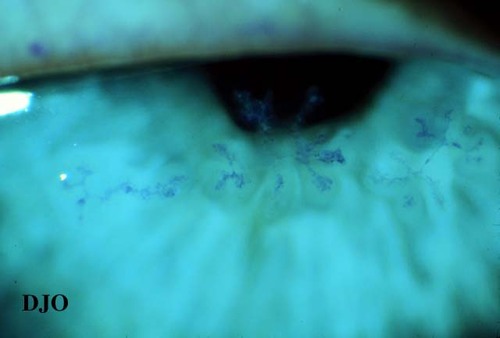Cornea/Refractive Surgery Quiz 3

Figure 1a
Figures 1a-1b. Photographs of a 39 year old man who presented with severe eye pain.
Figures 1a-1b. Photographs of a 39 year old man who presented with severe eye pain.

Figure 1b
Answer: Herpes simplex keratitis. The dendritic lesion with terminal bulbs is classic HSV keratitis.
2. What else might you consider in the differential diagnosis?
Answer: 1) Herpes zoster, however HZV dendrites typically do not have terminal bulbs. 2) A healing recurrent erosion might appear as a pseudo-dendrite. 3) Pseudo-dendrites are also seen in some contact lens wearers.
3. What additional work up is needed?
Answer: HSV keratitis can present in many forms. When the appearance is classic no additional work up is necessary as the diagnosis can be made clinically. If the appearance is atypical however the work up might include a Tzank smear, viral culture, or even PCR
4. What treatment would you recommend?
Answer: Trifluorothymidine 1% (Viroptic) 9 times per day. Alternatively, 3% vidarabine ointment (Vira A) may be used 5 times a day. The patient should be examined about 48 hours after starting treatment to evaluate therapeutic efficacy. Further follow up should be at relatively frequent intervals which are based on the response to treatment.
5. What are the complications of ocular HSV infection?
Answer: 1) Neurotrophic ulcers may result FROM decreased corneal sensation. 2) HSV may result in corneal stromal disease in the form of disciform keratitis, or necrotizing interstitial keratitis. 3) HSV can cause an anterior uveitis even in the absence of corneal disease. 4) HSV can also rarely cause retinitis.